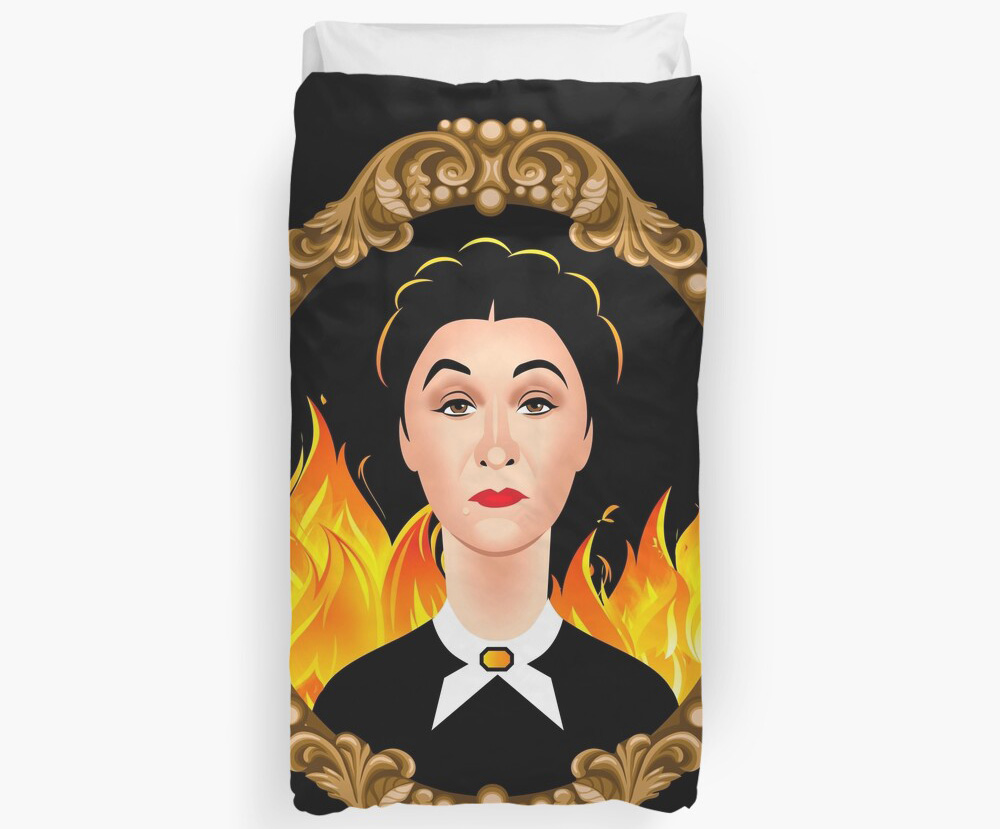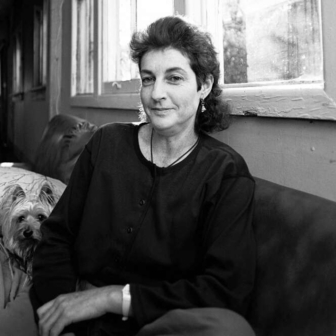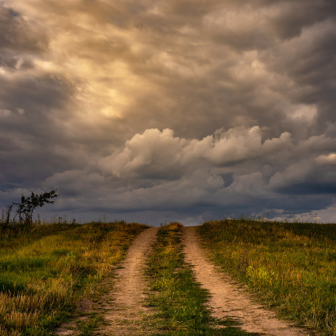It is ironic that a woman acknowledged as one of the greatest dramatic actresses of her time is mainly remembered today for a single role: as the menacing housekeeper, Mrs Danvers, in Hitchcock’s 1940 classic, Rebecca. That performance transformed Australia-born actress Judith Anderson into the most unlikely of popular culture icons, her devotees using her image on tee-shirts and coffee mugs, naming racehorses, girl bands and cafes after her, portraying her in spiky modernistic artworks and recreating memorable scenes from the movie in public mosaics.
Above all, Anderson has become a lesbian icon, celebrated for the boudoir scene in Rebecca in which she mesmerises the timid second Mrs de Winter with a sensual display of her predecessor’s underclothes and transparent nightwear.
When Judith Anderson made Rebecca at the end of 1939 she was forty-two years old, already a Broadway star of thirteen years’ standing and acknowledged as a first lady of the American stage. After appearing on Broadway with the young John Gielgud in Hamlet and at the Old Vic, London, with the even younger Laurence Olivier in Macbeth, she retired from the stage following her marriage to Berkeley professor Ben Lehman. A year later, longing for a whiff of greasepaint, she returned to the stage — and single life — with an extraordinary portrayal of Mary, mother of Jesus, in Family Portrait.
David O. Selznick had just bought Daphne du Maurier’s bestselling novel Rebecca, and was looking for an actress to play the central role of Mrs Danvers. His talent scout in New York wrote to him excitedly about Anderson’s brilliant success: “You have long been interested in this magnificent actress. She would be marvellous.” As Anderson put it in her unpublished memoirs, “I made the screen test. I got the job.”
This was not Judith Anderson’s first movie. In 1933 she had played a sultry nightclub owner in Blood Money — now considered a classic, though at the time Anderson’s talent on the screen was recognised only by the London Times. Unlike Blood Money, though, Rebecca had to conform to America’s prudish new Motion Picture Production Code. Writing to Selznick in 1939, the censor emphasised that there must be no suggestion that the first Mrs de Winter was “a sex pervert.” Despite this admonition, Anderson managed, with the aid of director Alfred Hitchcock, to convey a subtext of lesbianism that was immediately clear to a knowing audience.

Boudoir scene: a duvet cover featuring artist Alejandro Mogollo’s image of Mrs Danvers. Redbubble
Rebecca was an enormous hit when it was released in 1940, and was nominated for eleven Academy Awards the following year. Anderson’s nomination for best supporting actress lost to Jane Darwell in Grapes of Wrath, but her portrayal of Mrs Danvers has remained among the greatest villains of movie history. Rebecca was originally promoted as a love story, with Laurence Olivier and newcomer Joan Fontaine as the central figures. But interest quickly turned to the spine-tingling Mrs Danvers. Publicity for the film soon featured what has become the classic image of Anderson standing behind Fontaine urging her to “Jump, jump.”
Although commentators recognised Mrs Danvers’s sexuality from the beginning, it did not become an object of widespread analysis until the 1970s, when popular and academic work influenced by the feminist and gay movements turned the spotlight onto Hitchcock’s ambiguous creation.
After Laura Mulvey published her path-breaking article “Visual Pleasure and Narrative Cinema” in 1975, applying feminist psychoanalytic theory to Hitchcock’s movies, an avalanche of articles and books made images of Anderson in Rebecca iconic of the Hollywood lesbian. At a more popular level, Gay Activists Alliance member Vito Russo — whose lectures throughout the United States from 1972 to 1982 included clips of Hollywood’s treatment of gay, lesbian, bisexual and transgender characters — included Rebecca in his 1981 book The Celluloid Closet: Homosexuality in the Movies. The HBO documentary of the same name, narrated by Lily Tomlin and released in 1996, placed Rebecca and Mrs Danvers at centre stage and made the boudoir scene an important part of the general public’s image of the lesbian on film.
Rebecca itself was brought out in a deluxe edition DVD by Criterion in 2001, with Anderson menacing Fontaine on the cover. When Criterion issued a Blu-ray version in 2017 the cover featured Anderson alone, exhibiting the “sinister menace” that had seemed to act as a codeword for “lesbian” when the movie was made.
Since 1975, Judith Anderson (or Mrs Danvers) has become the poster girl for scholarly analyses of lesbian sexuality in film. As Patricia White points out, “Rebecca figures as insistently in feminist film theory as does Rebecca in the second Mrs de Winter’s psyche.” Two major academic books, The Women Who Knew Too Much (1988) and Uninvited (1999), have iconic images of Anderson and Fontaine on their covers — the scholarly counterpoint to the Garbo, Stanwyck and Deitrich trio on the covers or in the photographic pages of the more popular Sewing Circle: Sappho’s Leading Ladies (1995) by celebrity biographer, Axel Madsen, critic David Ehrenstein’s Open Secret: Gay Hollywood 1928–98 (1998) and journalist Diana McLellan’s The Girls: Sappho Goes to Hollywood (2001).
These popular books unquestioningly identify Anderson as a lesbian, usually without any attribution, following gossip columnist Boze Hadleigh’s dubious “outing” in Hollywood Lesbians (1994). Peter Conrad, reviewing Open Secret in the London Observer, described the boudoir scene in Rebecca as “the most candid account of a lesbian seduction ever filmed.” He accused the “bullish” Anderson of hypocrisy for denying knowledge that “such monstrous and unnatural females existed.” (Bullish is often used to describe Anderson, who was actually tiny and considered by her contemporaries the epitome of glamour.)
An article in the Glasgow Herald accompanying the screening of highlights of the 14th London Lesbian and Gay Film Festival in 2000 is typical in its equating of Mrs Danvers’s sexuality and that of Judith Anderson: “The archetypal Hollywood lesbian,” it read, “is arguably… Mrs Danvers, in Rebecca… Judith Anderson, who played her, is said to have belonged to the legendary Hollywood ‘sewing circle’ of actresses who were lesbian.”
Who was the real Judith Anderson? She began life in Adelaide in 1897 as Frances Margaret Anderson, the “unwanted child” of a failing marriage. She grew up in a close-knit family whose doughty mother, deserted by her husband, supported the four children by running a small grocery shop. Blessed with a rich, throaty voice and considerable talent and determination, she parlayed success in elocution competitions into a promising stage career as Francee Anderson in the company of Australia’s best-loved actor at the time, Julius Knight.
In 1918, disappointed with the opportunities available in Australia, the ambitious Francee followed other young Australians to Hollywood. Rejected as not pretty enough by Cecil B. De Mille, she went on to New York where, renamed Judith, her striking looks and obvious talent made her a star by 1925. After playing sophisticated modern roles for a decade, she starred in a series of Shakespearean roles until a landmark role in Medea, adapted for her by her friend, the California poet Robinson Jeffers, elevated her to international fame.
Despite her success in Rebecca, movies were always incidental to Anderson’s career, necessary to fund her “real” calling on the legitimate stage. Nevertheless, she played some memorable roles, as different as the elegant Ann Treadwell in Laura (1944), Ma Callum in Pursued (1947) and Big Mama in Cat on a Hot Tin Roof (1958). In the early 1950s, she began a third career in television, then in its golden age, winning Emmys in 1955 and 1961 for two portrayals of Lady Macbeth.
Late in a long career, Anderson played the supporting role of the Nurse to fellow-Australian Zoe Caldwell in Medea in 1982, when she was eighty-five years old. In 1984 she had a cameo role as the Vulcan High Priestess in Star Trek III: The Search for Spock; and from 1984 to 1987 she appeared in the American soap Santa Barbara.
Judith Anderson remained a steadfast Australian despite her long residence in the United States. She returned to her homeland in 1927 for an unhappy tour during which she was condemned for the overly sexual character of her plays. She inaugurated the Australian Elizabethan Theatre Trust in 1955 with a tour of Medea, and presented excerpts from Medea and Macbeth at the Adelaide Festival in 1966 — but her appearance there was eclipsed by the “rock star” Russian poet Yevgeny Yevtushenko, for whom she recited the English translation of his poems. She was made a Dame Commander of the British Empire for services to the performing arts in 1960 and, just before her death in 1992, a Companion of the Order of Australia.
The question of Judith Anderson’s sexuality remains debatable. She had many flirtations and she married twice; but each marriage was, in her words, “short, but far too long.” She was clearly attractive to women. The diarist Leo Lerman observed the lesbian writer, Jane Bowles, “yearning at her” at the closing night party for Bowles’s In the Summer House, in which Anderson had starred.
But the “archetypical Hollywood lesbian” she was not. An ambitious career woman, she struggled against typecasting in her life and in her work. From the age of eight she had refused to settle for the ordinary existence of a dependent woman. In 1924, when she had her first taste of success, she told Theatre Magazine that she wanted to play all sorts of women on the stage — “A whimsical creature, a capricious one, a woman of many contradictory moods, a cruel one, a malevolent one, a tender one, a woman broken on the wheels of her own emotions. Feline creatures, subtle, tricky, clever, selfish. All of them.” And at the end of her life, when gossip writer Boze Hadleigh tried to pin her down to a sexual identity, she sent him packing with the defiant words, “I do not associate myself with anyone — group or individual… I won’t join up with anything. Ever.”
When, in early childhood, she had seen in Nellie Melba’s performance “that quite indescribable miracle that a great talent can produce,” she had vowed that she too “must try in my own way to do to people what she, standing by a piano, was doing to me and to everyone in that theatre.” From that time, despite her many warm friendships, love affairs and two marriages, her great love was for her art, and she remained faithful to that to the end of her life. •
Desley Deacon’s Judith Anderson: Australian Star, First Lady of the American Stage has just been published by Kerr Publishing.




